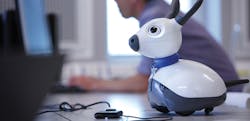A Look at the Healthcare of Tomorrow
Medicine is being impacted greatly by new and developing tech innovations over the last few years. These innovations include wireless devices, cloud computing and connectivity, the Internet of Things (IoT), 3D printing, and robotics. An article from The Telegraph featured interviews with experts in the field of medicine and their visions for the future of healthcare. Let’s examine what that future could be and how it will impact engineers.
Constant Connection Between Patients and Doctors
Patients suffer from their ailments 24/7, not just between the hours waiting in the doctor’s office. The future of healthcare monitoring should reflect a patient’s around the clock medical needs. According to Jeroen Tas, chief executive of Connected Care & Health Informatics at Philips, the current healthcare system is a “sickcare system.” The system has not evolved to deal with the growth of chronic diseases that represent well over 80% all healthcare spending.
Smart technology now allows for constant patient monitoring. Smartphones, wearables, and bioorganic implantable technology will allow for doctors to monitor their patients at all times and even deliver medical treatments wirelessly. In the future, doctors will be able to use tablets to make a movie of a patient’s heart and send them to a cardiologist for review. Patients can then network with doctors and specialists in a secure cloud environment, expediting consultation on difficult-to-diagnose cases.
For engineers this means that the future lies in wearable technology, sensing, and cloud computing. We will need computer, networking, electrical, and material engineers to design devices that can be worn and/or embedded in the patient for 24-hour monitoring. The data collected will lead to predictive maintenance of the human being.
Preventing Heart Disease with IoT
Establishing a connecting network of constant monitoring for a patient means we may be able to eliminate or reduce the occurrence of certain diseases. Over the past 50 years we have made significant gains in battling cardiovascular diseases, says Professor Metin Avkiran, associate medical director at the British Heart Foundation. However, we still have 17.5 million people globally that die from cardiovascular disease each year, which accounts for 30% of all deaths.
Advances in identifying genetic factors and specific biomarkers will help doctors treat patients in more exact ways and help prevent major cardiovascular risks before they become major health issues. Technologically speaking, new imaging techniques and wearable devices will help indemnify underlying biological processes in the body. For example, advanced imaging will be able to identity not just the blockage of an artery, but also the nature of the blockage.
Engineers working in wearable technology will be crucial as the need for more advanced devices rises. There will be a greater emphasis in gathering and analyzing large amounts of data. Battery life will be an issue, as most advanced wearables can only last a day or two. These devices also need constant connection to the cloud networking, demanding more from their internet connections. 5G networks will be helpful in ensuring data can be transmitted quickly.
Robots to Help the Elderly Live Independently
The MiRo robot from Consequential Robotics will provide the patient with companionship and help combat loneliness in the elderly.
According to Sebastian Conran, leading consumer product designer and co-founder of Consequential Robotics, companion robots will help the elderly maintain their independence. These robots will be able to respond naturally and help their elder patients by providing care and companionship. Psychologically, one of the more difficult aspects of getting older is combatting loneliness. Robots won’t replace a person fully but can fill a role similar to that of a pet, but without the caring responsibilities.
These companion robots will be able to remind patients of certain tasks like taking their medication, finding misplaced items, and retrieve certain items like a glass of water or the phone. Robotic design needs to advance significantly to achieve this level of sophistication. Japan has led the way with their companion robots, such as ones that can help lift patients out of bed. However, these are expensive and require a remote control operation. Robotic engineers and programmers will need to create more advanced robotic systems and artificial intelligence networks to interact naturally with patients.
The Cutting Edge of Nano-Medicine
Nanoscience is the new interdisciplinary field in the world of medicine. Studying materials and motion mechanisms at the nanoscale. Advances in developing nanostructures out of new materials have revealed new techniques in tackling disease. For example, gold at the nanoscale level is red but when grouped together, a gold cluster is blue. This type of material property can be used to detect small amounts of bacteria in the body, which is extremely hard to do today. Nano-biosystems can also be used to genetic mutations without the toxicity of today’s virus particle delivery system treatments.
The future of nano-medicine will depend on engineers and scientists working together on clinical trials. Material scientists and bioorganic engineers will need to develop delivery systems that rely on non-traditional motion systems. According to Sonia Trigueros, nano-bio-systems group leader at Oxford University and former co-director of the OMS Institute of Nanomedicine, we are 5 to 10 years from nanoscale medications becoming reality. They have the power to completely transform chemotherapy treatments, targeting cancer cells directly, as well as create a more efficient delivery system of antibiotics.
Beating Cancer with Individualized Treatment
Advances in targeted radiation will help increase the chances of surviving cancer from 50% to 75%. (Credit: AndreyPopov:iStock)
Today’s science world has helped to treat cancer using immunotherapy drugs. These treatments help the patient’s own body defenses attack and destroy the cancer cells. The future of attacking cancer is personalized medicine. Immunotherapy treatments are just the first step in providing more individualized care.
For example, certain types of cancers are incredibly hard to detect. Lung and skin cancer often go undiagnosed until it is too late. However, using more advanced blood tests, doctor’s will be able to detect New Robotic System Aims to Destroy Brain Tumorsearly signals for specific types of cancer. Advances in radiotherapy will help shape the beam and direct it more precisely on the patient’s cancer cells. This allows for a stronger dosage of radiation. 40% of all cancer patients in remission have undergone radiation. By increasing the possible dosage in a more direct delivery system, the number of patients cured with radiation can increase.
According to Professor Peter Johnson, Cancer Research UK’s chief clinician, the current odds of surviving cancer for 10 or more years in the United Kingdom are 50/50. The survival rate 40 years ago was 25%. Over the next 20 years, these odds can hopefully increase to 75% with new treatments.



